Qi Song
Align 3D Representation and Text Embedding for 3D Content Personalization
Aug 23, 2025Abstract:Recent advances in NeRF and 3DGS have significantly enhanced the efficiency and quality of 3D content synthesis. However, efficient personalization of generated 3D content remains a critical challenge. Current 3D personalization approaches predominantly rely on knowledge distillation-based methods, which require computationally expensive retraining procedures. To address this challenge, we propose \textbf{Invert3D}, a novel framework for convenient 3D content personalization. Nowadays, vision-language models such as CLIP enable direct image personalization through aligned vision-text embedding spaces. However, the inherent structural differences between 3D content and 2D images preclude direct application of these techniques to 3D personalization. Our approach bridges this gap by establishing alignment between 3D representations and text embedding spaces. Specifically, we develop a camera-conditioned 3D-to-text inverse mechanism that projects 3D contents into a 3D embedding aligned with text embeddings. This alignment enables efficient manipulation and personalization of 3D content through natural language prompts, eliminating the need for computationally retraining procedures. Extensive experiments demonstrate that Invert3D achieves effective personalization of 3D content. Our work is available at: https://github.com/qsong2001/Invert3D.
CrossLinear: Plug-and-Play Cross-Correlation Embedding for Time Series Forecasting with Exogenous Variables
May 29, 2025Abstract:Time series forecasting with exogenous variables is a critical emerging paradigm that presents unique challenges in modeling dependencies between variables. Traditional models often struggle to differentiate between endogenous and exogenous variables, leading to inefficiencies and overfitting. In this paper, we introduce CrossLinear, a novel Linear-based forecasting model that addresses these challenges by incorporating a plug-and-play cross-correlation embedding module. This lightweight module captures the dependencies between variables with minimal computational cost and seamlessly integrates into existing neural networks. Specifically, it captures time-invariant and direct variable dependencies while disregarding time-varying or indirect dependencies, thereby mitigating the risk of overfitting in dependency modeling and contributing to consistent performance improvements. Furthermore, CrossLinear employs patch-wise processing and a global linear head to effectively capture both short-term and long-term temporal dependencies, further improving its forecasting precision. Extensive experiments on 12 real-world datasets demonstrate that CrossLinear achieves superior performance in both short-term and long-term forecasting tasks. The ablation study underscores the effectiveness of the cross-correlation embedding module. Additionally, the generalizability of this module makes it a valuable plug-in for various forecasting tasks across different domains. Codes are available at https://github.com/mumiao2000/CrossLinear.
Advanced long-term earth system forecasting by learning the small-scale nature
May 26, 2025Abstract:Reliable long-term forecast of Earth system dynamics is heavily hampered by instabilities in current AI models during extended autoregressive simulations. These failures often originate from inherent spectral bias, leading to inadequate representation of critical high-frequency, small-scale processes and subsequent uncontrolled error amplification. We present Triton, an AI framework designed to address this fundamental challenge. Inspired by increasing grids to explicitly resolve small scales in numerical models, Triton employs a hierarchical architecture processing information across multiple resolutions to mitigate spectral bias and explicitly model cross-scale dynamics. We demonstrate Triton's superior performance on challenging forecast tasks, achieving stable year-long global temperature forecasts, skillful Kuroshio eddy predictions till 120 days, and high-fidelity turbulence simulations preserving fine-scale structures all without external forcing, with significantly surpassing baseline AI models in long-term stability and accuracy. By effectively suppressing high-frequency error accumulation, Triton offers a promising pathway towards trustworthy AI-driven simulation for climate and earth system science.
ADGaussian: Generalizable Gaussian Splatting for Autonomous Driving with Multi-modal Inputs
Apr 01, 2025Abstract:We present a novel approach, termed ADGaussian, for generalizable street scene reconstruction. The proposed method enables high-quality rendering from single-view input. Unlike prior Gaussian Splatting methods that primarily focus on geometry refinement, we emphasize the importance of joint optimization of image and depth features for accurate Gaussian prediction. To this end, we first incorporate sparse LiDAR depth as an additional input modality, formulating the Gaussian prediction process as a joint learning framework of visual information and geometric clue. Furthermore, we propose a multi-modal feature matching strategy coupled with a multi-scale Gaussian decoding model to enhance the joint refinement of multi-modal features, thereby enabling efficient multi-modal Gaussian learning. Extensive experiments on two large-scale autonomous driving datasets, Waymo and KITTI, demonstrate that our ADGaussian achieves state-of-the-art performance and exhibits superior zero-shot generalization capabilities in novel-view shifting.
Unleashing the Potential of Two-Tower Models: Diffusion-Based Cross-Interaction for Large-Scale Matching
Feb 28, 2025Abstract:Two-tower models are widely adopted in the industrial-scale matching stage across a broad range of application domains, such as content recommendations, advertisement systems, and search engines. This model efficiently handles large-scale candidate item screening by separating user and item representations. However, the decoupling network also leads to a neglect of potential information interaction between the user and item representations. Current state-of-the-art (SOTA) approaches include adding a shallow fully connected layer(i.e., COLD), which is limited by performance and can only be used in the ranking stage. For performance considerations, another approach attempts to capture historical positive interaction information from the other tower by regarding them as the input features(i.e., DAT). Later research showed that the gains achieved by this method are still limited because of lacking the guidance on the next user intent. To address the aforementioned challenges, we propose a "cross-interaction decoupling architecture" within our matching paradigm. This user-tower architecture leverages a diffusion module to reconstruct the next positive intention representation and employs a mixed-attention module to facilitate comprehensive cross-interaction. During the next positive intention generation, we further enhance the accuracy of its reconstruction by explicitly extracting the temporal drift within user behavior sequences. Experiments on two real-world datasets and one industrial dataset demonstrate that our method outperforms the SOTA two-tower models significantly, and our diffusion approach outperforms other generative models in reconstructing item representations.
KnowPath: Knowledge-enhanced Reasoning via LLM-generated Inference Paths over Knowledge Graphs
Feb 17, 2025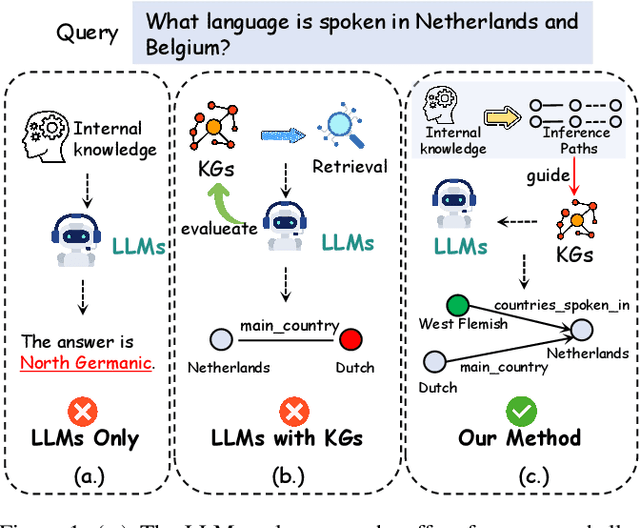
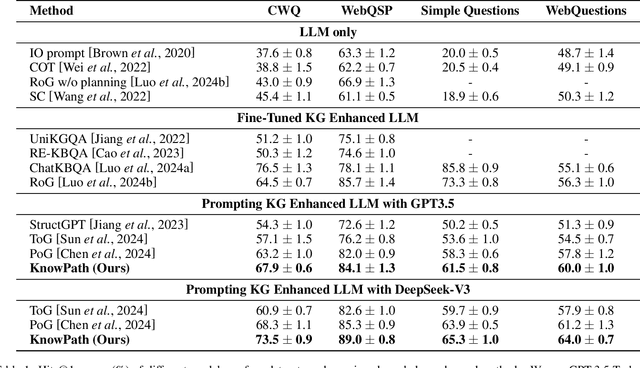


Abstract:Large language models (LLMs) have demonstrated remarkable capabilities in various complex tasks, yet they still suffer from hallucinations. Introducing external knowledge, such as knowledge graph, can enhance the LLMs' ability to provide factual answers. LLMs have the ability to interactively explore knowledge graphs. However, most approaches have been affected by insufficient internal knowledge excavation in LLMs, limited generation of trustworthy knowledge reasoning paths, and a vague integration between internal and external knowledge. Therefore, we propose KnowPath, a knowledge-enhanced large model framework driven by the collaboration of internal and external knowledge. It relies on the internal knowledge of the LLM to guide the exploration of interpretable directed subgraphs in external knowledge graphs, better integrating the two knowledge sources for more accurate reasoning. Extensive experiments on multiple real-world datasets confirm the superiority of KnowPath.
PoI: Pixel of Interest for Novel View Synthesis Assisted Scene Coordinate Regression
Feb 07, 2025Abstract:The task of estimating camera poses can be enhanced through novel view synthesis techniques such as NeRF and Gaussian Splatting to increase the diversity and extension of training data. However, these techniques often produce rendered images with issues like blurring and ghosting, which compromise their reliability. These issues become particularly pronounced for Scene Coordinate Regression (SCR) methods, which estimate 3D coordinates at the pixel level. To mitigate the problems associated with unreliable rendered images, we introduce a novel filtering approach, which selectively extracts well-rendered pixels while discarding the inferior ones. This filter simultaneously measures the SCR model's real-time reprojection loss and gradient during training. Building on this filtering technique, we also develop a new strategy to improve scene coordinate regression using sparse inputs, drawing on successful applications of sparse input techniques in novel view synthesis. Our experimental results validate the effectiveness of our method, demonstrating state-of-the-art performance on indoor and outdoor datasets.
Geometry Cloak: Preventing TGS-based 3D Reconstruction from Copyrighted Images
Oct 30, 2024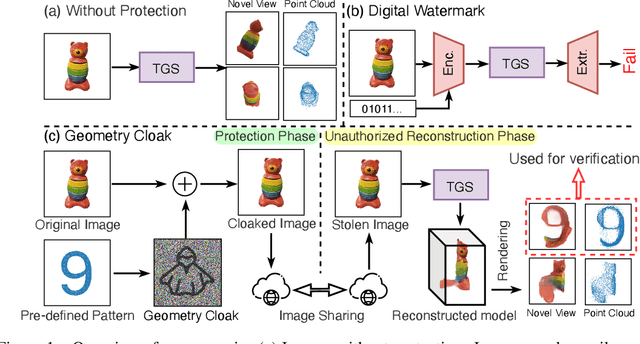
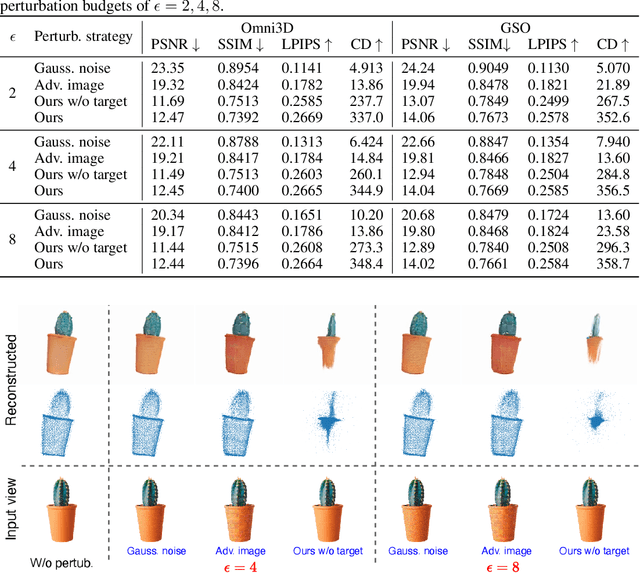
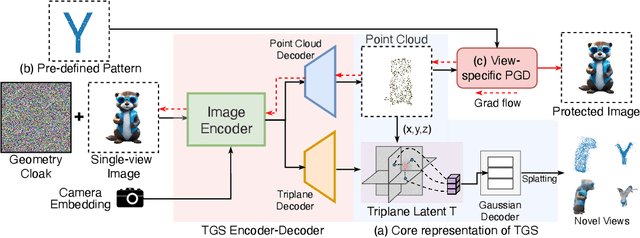

Abstract:Single-view 3D reconstruction methods like Triplane Gaussian Splatting (TGS) have enabled high-quality 3D model generation from just a single image input within seconds. However, this capability raises concerns about potential misuse, where malicious users could exploit TGS to create unauthorized 3D models from copyrighted images. To prevent such infringement, we propose a novel image protection approach that embeds invisible geometry perturbations, termed "geometry cloaks", into images before supplying them to TGS. These carefully crafted perturbations encode a customized message that is revealed when TGS attempts 3D reconstructions of the cloaked image. Unlike conventional adversarial attacks that simply degrade output quality, our method forces TGS to fail the 3D reconstruction in a specific way - by generating an identifiable customized pattern that acts as a watermark. This watermark allows copyright holders to assert ownership over any attempted 3D reconstructions made from their protected images. Extensive experiments have verified the effectiveness of our geometry cloak. Our project is available at https://qsong2001.github.io/geometry_cloak.
Enhancing Playback Performance in Video Recommender Systems with an On-Device Gating and Ranking Framework
Oct 08, 2024Abstract:Video recommender systems (RSs) have gained increasing attention in recent years. Existing mainstream RSs focus on optimizing the matching function between users and items. However, we noticed that users frequently encounter playback issues such as slow loading or stuttering while browsing the videos, especially in weak network conditions, which will lead to a subpar browsing experience, and may cause users to leave, even when the video content and recommendations are superior. It is quite a serious issue, yet easily overlooked. To tackle this issue, we propose an on-device Gating and Ranking Framework (GRF) that cooperates with server-side RS. Specifically, we utilize a gate model to identify videos that may have playback issues in real-time, and then we employ a ranking model to select the optimal result from a locally-cached pool to replace the stuttering videos. Our solution has been fully deployed on Kwai, a large-scale short video platform with hundreds of millions of users globally. Moreover, it significantly enhances video playback performance and improves overall user experience and retention rates.
Divide and Conquer: Improving Multi-Camera 3D Perception with 2D Semantic-Depth Priors and Input-Dependent Queries
Aug 13, 2024Abstract:3D perception tasks, such as 3D object detection and Bird's-Eye-View (BEV) segmentation using multi-camera images, have drawn significant attention recently. Despite the fact that accurately estimating both semantic and 3D scene layouts are crucial for this task, existing techniques often neglect the synergistic effects of semantic and depth cues, leading to the occurrence of classification and position estimation errors. Additionally, the input-independent nature of initial queries also limits the learning capacity of Transformer-based models. To tackle these challenges, we propose an input-aware Transformer framework that leverages Semantics and Depth as priors (named SDTR). Our approach involves the use of an S-D Encoder that explicitly models semantic and depth priors, thereby disentangling the learning process of object categorization and position estimation. Moreover, we introduce a Prior-guided Query Builder that incorporates the semantic prior into the initial queries of the Transformer, resulting in more effective input-aware queries. Extensive experiments on the nuScenes and Lyft benchmarks demonstrate the state-of-the-art performance of our method in both 3D object detection and BEV segmentation tasks.
 Add to Chrome
Add to Chrome Add to Firefox
Add to Firefox Add to Edge
Add to Edge